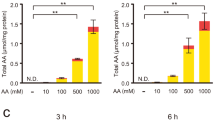Summary
The action of small doses of ultraviolet light on epidermal cells ofAllium cepa was investigated by incubating preparations after irradiation in a 0,004% solution of p-nitroblue tetrazolium chloride. First formazan deposits appeared in unirradiated cells after an incubating time of 2–3 hours, after 7 hours formazan deposits were observed in each cell of the preparation.
Formazan formation was significantly reduced after irradiation with sublethal doses. Larger UV-doses inhibited formazan formation at all. Cells damaged by higher doses died during incubation, in the dead cells formazan formation occured very rapidly. Similar results were observed after adding NADH to the incubation medium. The most possible explanation is a diminished or inhibited oxidation of substrates via the respiratory chain in surviving cells caused by UV-action on the oxidative phosphorylation or the ATP/ADP carrier system in the mitochondrial membran.
Zusammenfassung
Bei Inkubation von Präparaten der inneren Epidermis der Schuppenblätter vonAllium cepa in einer 0,004%-Lösung von p-Nitroblau Tetrazoliumchlorid waren erste Formazanniederschläge in jeder Zelle nach etwa 7 Stunden zu beobachten. Geringe UV-Bestrahlung verlangsamte die Formazanbildung, größere, noch nicht tödlich wirkende Strahlendosen unterbanden die Formazanbildung überhaupt, solange die Zellen am Leben blieben. Mit innerhalb von 24 Stunden tödlich wirkenden Dosen bestrahlte Präparate starben in der Inkubationslösung nach kurzer Zeit ab, in den toten Zellen erfolgte rasche Formazanbildung. Ähnliche Ergebnisse wurden auch bei Inkubation in einem NADH-haltigen Medium beobachtet. Als Erklärung wird eine Verlangsamung oder Hemmung der Oxidation von Substraten über die Atmungskette angenommen, die möglicherweise auf die Beeinträchtigung der oxidativen Phosphorylierung oder des ADP/ATP Carriers in der Mitochondrienmembran zurückgeht.
Similar content being viewed by others
Literatur
Altmann, F. P., 1972: Quantitative dehydrogenase histochemistry with special reference to the pentose shunt dehydrogenases. Prog. Histochem. Cytochem.4, 225–273.
Beyer, R. E., 1959: The effect of ultraviolet light on mitochondria. I. Inactivation and protection of oxidative phosphorylation during far-ultraviolet irradiation. Arch. Biochem. Biophys.79, 269–274.
Biebl, R., undW. Url, 1958: UV-Strahleneinwirkungen auf Zellen vonAllium cepa, besonders deren Chondriosomen und Plastiden. Protoplasma49, 329–352.
Dallam, R. D., andW. W. Anderson, 1957: Vitamin K1 and oxidative phosphorylation. Biochim. biophys. Acta25, 439.
Deane, H. W., R. J. Barnett undA. M. Seligman, 1960: Histochemische Methoden zum Nachweis der Enzymaktivität. In: Handbuch der Histochemie, Bd. VII/1. (W. Graumann undK. Neumann, Hrsg.) Stuttgart: Fischer-Verlag.
Erećinska, M., 1967: The effect of far ultraviolet light on mitochondria. Acta biochim. Polon.14, 21–30.
Hagen, V., undH. Langendorff, 1960: Einfluß der ionisierenden und der UV-Strahlung auf die Atmung. In: Handbuch der Pflanzenphysiologie, Bd. XII/2, pp. 334–346 (W. Ruhland, Hrsg.). Berlin-Göttingen-Heidelberg: Springer-Verlag.
Hauser, E. J. P., andJ. M. Morrison, 1964: The cytochemical reduction of nitro blue tetrazolium as an index of pollen viability. Amer. J. Bot.51, 748–752.
Hildebrand, E., undH. Stieve, 1972: Die Wasser- und Ionen-Permeabilität der Zellmembran von Protozoen unter Einwirkung von ultraviolettem Licht. Z. Naturforsch.27 b, 1243–1257.
Kartusch, R., 1972: Wirkung fraktionierter UV-Bestrahlung auf Epidermiszellen vonAllium cepa. Protoplasma74, 85–101.
Kiefer, J., 1971: The importance of cellular energy metabolism for the sparing effect of dose fractionation with electrons and ultra-violet light. Int. J. Radiat. Biol.20, 325–336.
Lakon, G., 1942: Topographischer Nachweis der Keimfähigkeit der Getreidefrüchte durch Tetrazoliumsalze. Ber. dtsch. bot. Ges.60, 299–305.
Larcher, W., undH. Eggarter, 1960: Anwendung des Triphenyltetrazoliumchlorids zur Beurteilung von Frostschäden in verschiedenen Achsengeweben beiPirus-Arten, und Jahresgang der Resistenz. Protoplasma51, 595–619.
Lehmann, J., 1973: Zur Lokalisation von Dehydrogenasen des Energiestoffwechsels im Phloem vonCucurbita pepo. Planta111, 187–198.
Marzoev, A. I., D. I. Roshchupkin, andYu. A. Vladimirov, 1973: Study of the effect of ultraviolet light on biomembranes. II. Action of irradiation on chemoluminescence in mitochondria suspensions. Biofizika18, 258–263.
Nachlas, M. M. S., S. Margulies, andA. M. Seligman, 1960: Sites of electron transfer to tetrazolium salts in the succinoxidase system. J. biol. Chem.235, 2739–2743.
Pearse, A. G. E., 1961: Histochemistry. Theoretical and applied. 2. ed., London: J. and A. Churchill.
Reiss, J., 1967 a: Der cytochemische Nachweis von Dehydrogenasen bei Pilzen. I. Arch. Mikrobiol.57, 285–306.
—, 1967 b: Der cytochemische Nachweis von Dehydrogenasen bei Pilzen. II. Arch. Mikrobiol.57, 307–334.
Roshchupkin, D. I., A. I. Marzoev, andYu. A. Vladimirov, 1973: Study of the effect of ultra-violet light on biomembranes. I. Alteration of oxidative phosphorylation and protein state changes during irradiation of isolated mitochondria. Biofizika18, 83–88.
Sauter, J. J., undH. Braun, 1972: Cytochemische Untersuchungen der Atmungsaktivität in den Strasburger-Zellen vonLarix und ihre Bedeutung für den Assimilattransport. Z. Pflanzenphysiol.66, 440–458.
Slater, T. F., B. Sawer, andU. Strauli, 1963: Studies on succinate-tetrazolium reductase system. III. Points of coupling of four different tetrazolium salts. Biochim. biophys. Acta77, 383–393.
Sorokin, H. P., andS. Sorokin, 1956: Staining of mitochondria with neotetrazolium chloride. Amer. J. Bot.43, 183–190.
Strugger, S., 1935: Praktikum der Zell- und Gewebephysiologie. Berlin: Gebr. Borntraeger.
Trebst, A., undE. Pistorius, 1965: Photosynthetische Reaktionen in UV-bestrahlten Chloroplasten. Z. Naturforsch.20 b, 885–889.
Van Fleet, D. S., 1962: Histochemistry of Enzymes in Plant Tissues. In: Handbuch der Histochemie, Bd. VII/2, S. 1–38 (W. Graumann undK. Neumann, Hrsg.). Stuttgart: Fischer-Verlag.
Ziegler, H., 1953: Über die Reduktion des Tetrazolium-Chlorids in der Pflanzenzelle und über den Einfluß des Salzes auf Stoffwechsel und Wachstum. Z. Naturforsch.8 b, 662–667.
Author information
Authors and Affiliations
Additional information
Der Autor dankt Herrn Prof. H.Kinzel für anregende Diskussion und Frl.Marianne Popp für die Durchfüng der gaschromatographischen Untersuchungen.
Rights and permissions
About this article
Cite this article
Kartusch, R. Wirkung kleiner UV-Dosen auf die Reduktion von Nitroblau-Tetrazoliumchlorid in Epidermiszellen vonAllium cepa L.. Protoplasma 81, 383–392 (1974). https://doi.org/10.1007/BF01281051
Received:
Issue Date:
DOI: https://doi.org/10.1007/BF01281051




